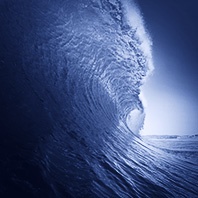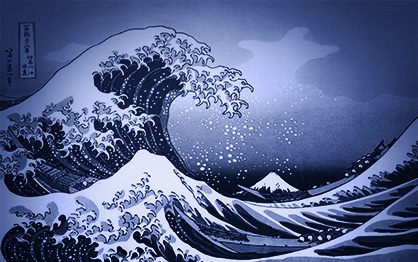Tsunami at the full moon?

Repeated attempts have been made creating a connection between lunar phases and natural disasters. To our knowledge, it has not been possible so far, to establish nor prove a causal link. Of particular note is the well known earthquake and tsunami in the Indian Ocean in 2004, which happened at the full moon. Was this a coincidence? Were there other tsunamis that occurred during a full moon?
A tsunami is a large water wave that is usually triggered by seaquakes or by large landslides slipping into the ocean. Such waves are initially flat in the deep water, but move as fast as an airplane and turn into towering waves in shallow coastal areas, with heights of up to 55 yards or more. The resulting power of destruction has a catastrophic impact and claims thousands of human lives.
When examining the connection to the Moon, one initially thinks of the tides, which are known to be caused by the Moon. Furthermore, there are so called spring tides, at the full moon or at the new moon (opposition or conjunction Sun and Moon), which can cause tidal waves in the region of a river mouth. This phenomenon, however, is not enough to create a tsunami. And there is no connection between earthquakes and the Moon.

Assuming that there is NO link between the full moon and a tsunami, the probability that such an incident occurs COINCIDENTALLY at the full moon (+/– 12 hours), is approximately 3.4 % (thus 1 divided by 29.5 days of the lunar cycle). If we expand this time period to +/– 24 hours around the full moon, the chance probability would be 6.8 % (thus 2 divided by 29.5 days).
We have found a total of 22 large, documented tsunami disasters between 1905 and 2011. In statistical terms, not one of these incidents should have occurred +/– 12 hours around the full moon (3.4 % times 22 = 0.75 incident) and only about 1.5 incidents +/– 24 hours around the full moon (6.8 % times 22). But there was one catastrophe only with 1 hour time difference to the full moon and in total 4 catastrophes in the time period of +/– 24 hours, which would equal a hit rate of 18.2 % … remarkable, on the basis of 6.8 % chance probability!
Tsunami Solomon Islands
Earthquake 01.04.2007, 8:39 pm (UTC)
Full moon 02.04.2007, 5:15 pm (UTC)
Difference approx. 20.6 hoursTsunami Indian Ocean
Earthquake: 26.12.2004, 12:58 am (UTC)
Full moon: 26.12.2004, 3:06 pm (UTC)
Difference approx. 14.1 hoursTsunami Japan
Earthquake: 26.05.1983, 3:00 am (UTC)
Full moon: 26.05.1983, 6:47 pm (UTC)
Difference approx. 15.8 hoursTsunami Alaska (»Good Friday Earthquake«)
Earthquake: 28.03.1964, 3:36 am (UTC)
Full moon: 28.03.1964, 2:48 am (UTC)
Difference approx. 0.8 hours
Now, it would require a statistics expert to tell us, how such a high hit rate could be explained and whether this is significant to consider a link between tsunamis and the full moon. If someone happens to read this and is able to contribute, please feel free to make a post in the comment section below.

Apart from the huge toll of human casualties and fateful cuts into the lives of so many people, there are also geophysical consequences due to these gigantic quakes. Scientists from NASA discovered that because of the moving earth masses during the quake in 2004, the length of the days has been reduced by 2.68 micro seconds. In addition, there was a shift in the Earth’s axis of almost 1 inch. 15 smaller islands of the Andaman and Nicobar Islands sank because of the shift of the tectonic plates.
Let’s hope that we will all be spared of the effects of such disasters in the future. Fortunately, the early warning systems are continuously improving …
